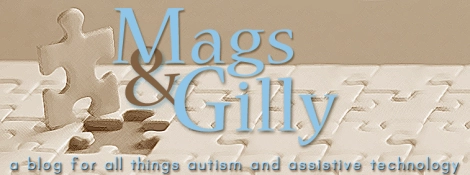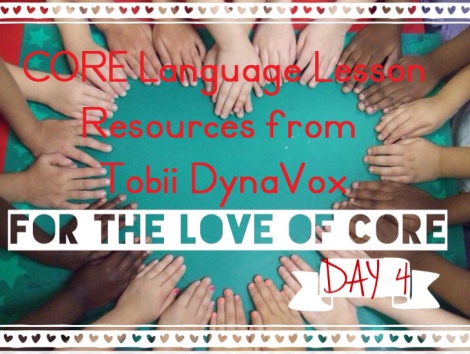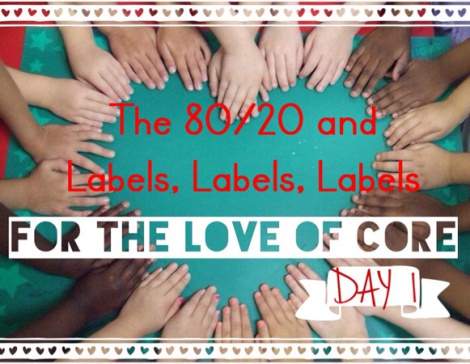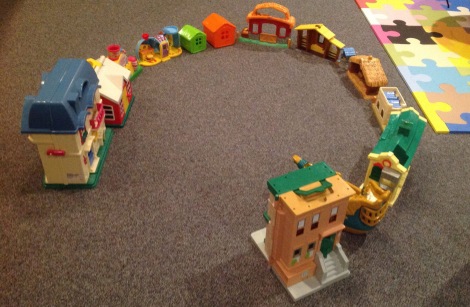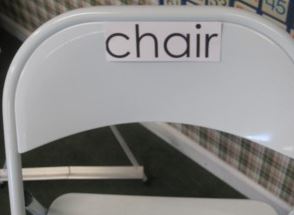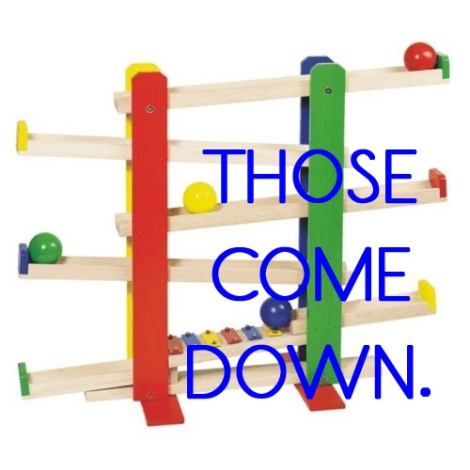February 8, 2015
For the LOVE of CORE Day 7: Check THIS Pinterest Page
February 7, 2014
Do you Pinterest? Do you use those ‘Pin This’ buttons when browsing the internet? There is a Pinterest that should be of most interest to you if AAC, Assistive Technology, iOS apps and more ring your bell. With more than 150 boards, 17,000 pins and nearly 25,000 followers, the Pinterest page of Lauren S. Enders MA, CCC-SLP is a treasure trove of quick links to all kinds of important and interesting information for working with AAC and Assistive Technology. Lauren is a SLP, AAC and AT consultant from Pennsylvania. I was blessed to have heard her speak at ATIA 2014 for ideas on infusing core vocabulary across the curriculum.
Of course with this current blog series “For the LOVE of CORE”, take a look at the board called AAC: Vocabulary Selection Supports/Core Vocabulary. With over 140 pins of core vocabulary resources, some of my favorites are:
The Language Stealers
The Language Stealers is a short video demonstrating the importance of core words for those who use AAC.
DLM “First 40” words for AAC users
This grid of 40 core vocabulary words from Dynamic Learning Maps is an extension of DLM work in relation to the Common Core Essential Elements and alternative assessment for students with disabilities. The “First 40” is a helpful list to reference and focus on when establishing AAC systems for emergent communicators and when trying to target the modeling and use of more core words in existing AAC systems. I blogged about “Autism, Special Needs and the Common Core” in a previous post.
SNUG Video
This AssistiveWare training video on Autism and AAC features the work of AAC specialist Joanne Cafiero PhD. In the video she highlights the SNUG acronym, a ultimate goal for any AAC user: Spontaneous Novel Utterance Generation.
Keep Calm and Say a lot with Core Words
I love this meme and the resources here! A great post again from PrAACtical AAC with a yearly round-up of many blog posts to help with core word instruction and implementation.
~KVS
“For I know the plans I have for you,” declares the Lord, “plans to prosper you and not to harm you, plans to give you hope and a future.” ~Jeremiah 29:11.
Permalink Comments off
February 6, 2015
For the LOVE of CORE Day 6: See THIS Blog…PrAACtical AAC
February 6, 2014
One of my absolutely favorite blog and web resources is PrAACtical AAC. Created in 2012 by two master professors of speech and language pathology: Carole Zangari and Robin Parker. Sadly, Robin Parker passed away in July 2014. But her work lives on in this wonderful blog with and in the “Robin’s Tree of Learning” resource page at CARD which stands for the Center for Autism & Related Disabilities which is based at the University of Miami and Nova Southeastern University. There are over sixty webinars cataloged here on a variety of autism-related topics, including assistive technology.
You may have noticed some links to PrAACtical AAC in previous posts. There are a wealth of resources about the importance of core vocabulary as well as ideas for lesson plans and implementation. A fabulous resource for helping to implement strategies for the learning, practicing and using of core words all year long are the downloadable resources of A Year of Core Words 2013 and Another Year of Core Words 2014. Both blog entries contain a downloadable word document complete with grid communication boards and targeted words for each month of the year. Each grid is a template grid so that any choice of symbol set from your AAC user’s communication system can be used, be it PCS, SymbolStix or otherwise.
There are also some of the monthly grids available complete with symbols in the PrAACtical AAC tools resource page. Thank you Carole and Robin for the wonderful resources you have created for the AAC and AT community!
~KVS
“For I know the plans I have for you,” declares the Lord, “plans to prosper you and not to harm you, plans to give you hope and a future.” ~Jeremiah 29:11.
Permalink Comments off
February 5, 2015
For the LOVE of CORE Day 5: Core Word Sentence Building with Clicker Apps
February 5, 2014
Crick Software out of the UK has been making Clicker software to aid in reading and writing instruction for many years. You can actually try Clicker free for 30 days on PC with a download of their trial version. Writing, Sentence Building and more literacy activities are now available for iOS with their series of apps: Clicker Sentences, Clicker Connect, Clicker Books, and Clicker Docs.
Before the availability of the iOS Apps, we used Clicker 5 at home and at school to write a daily note about what Mags would do each day at school. It was a very successful way for Mags to understand sentence structure and it provided her with a literacy support of a word and symbol bank to help write her daily note.
I was so excited when Crick started to release their iOS apps. My favorite for emergent literacy students like Gilly is Clicker Sentences. It sells for $30.99 on the app store. Recently, apple has now started giving developers the option of selling several apps together in a bundle. Clicker Sentences, Clicker Connect, Clicker Books, and Clicker Docs bundled for $89.99 is a good value. Schools can save even more when purchasing any of the Clicker Apps with the Volume Purchasing Program.
I created a sentence building activity for Gilly with some of her favorite Sesame Street characters. It incorporates the core words is and a / an into a simple sentence structure about each monster’s color:
Here is another Clicker Sentences activity using see and a about farm animals. In this screenshot you can see that a sentence model is also provided on the grid below the writing window.
 Clicker Sentences allows you to scaffold the difficulty of the writing task by various options for Model Sentence and Word Order. In Model Sentence for each grid, you can select None, On Grid, In Pop-up or Spoken for the sentence model. In Word Order for each grid, you can select Alphabetical, Random, Sentence Order, or Guided Order for the word buttons.
Clicker Sentences allows you to scaffold the difficulty of the writing task by various options for Model Sentence and Word Order. In Model Sentence for each grid, you can select None, On Grid, In Pop-up or Spoken for the sentence model. In Word Order for each grid, you can select Alphabetical, Random, Sentence Order, or Guided Order for the word buttons.
Clicker Connect can also be used for emergent sentence writing and can do more complex writing tasks. Here is an example of a sentence building activity using has and use.
It is very easy to find and use your own choice of pictures for writing activities in Clicker Apps. Use the camera to take your own pictures, or use an image search engine such as google to easily find photos for your writing activities. For example, look at the all of the pictures that instantly come up when doing a search for “boy holding ball” via images.google.com:
You could also pair any of these activities with the student’s dedicated AAC device or second iOS device, Encourage them to also build the sentences on their device or in their AAC app to match the sentences created in the Clicker app.
~KVS
“For I know the plans I have for you,” declares the Lord, “plans to prosper you and not to harm you, plans to give you hope and a future.” ~Jeremiah 29:11.
Permalink Comments off
February 4, 2015
For the LOVE of CORE Day 4: Core Language Lesson Resources from Tobii DynaVox
February 4, 2014
If you are looking for some ideas and lesson plans for implementing more core words into communication practice, this post is for you. I will be sharing several resources during the month. Today’s resource pick is from Tobii DynaVox. The website www.mydynavox.com is full of resources for implementing AAC and encouraging language growth with AAC. They have provided not only one set of core lesson plans, but just released set two. There is a 100+ page PDF lesson guide along with multiple PDF books for each of the targeted core words that are available for FREE (just create a login and password for yourself to access of all the mydynavox.com materials for free).
DynaVox Core Lesson Plan Set 1 covers words:
- GO
- WANT
- MORE
- STOP
- LIKE
- NOT
- I
- YOU
- IT
- IS
- CAN
- DO
DynaVox Core Lesson Plan 2 covers words:
- A
- HAVE
- HE
- HELP
- KNOW
- THAT
- THE
- THIS
For example, here are a few screenshots from the picture story book Go! Go! Go! for the target core word GO:
etc. etc. etc.
*TIP:* for the conserving of paper and for having your core lesson storybooks with you wherever you go, download each PDF and save on the PDF bookshelf in iBooks on your iOS device. Another possible idea is to present the book big screen style on your classroom projector based whiteboard or smartboard for whole group literacy and core language instruction. In total there are nearly 70 PDF picture and photo story books in lesson one and lesson two. This a powerful and robust resource for core word modeling and language instruction in AAC users.
You can also use the scripts and storylines from the PDF storybooks to help create your own customized core word books. Incorporate the AAC user’s favorite TV or cartoon characters, classmates, or family members into the story if that might be more fun and motivating for core word practice The possibilities are endless.
~KVS
“For I know the plans I have for you,” declares the Lord, “plans to prosper you and not to harm you, plans to give you hope and a future.” ~Jeremiah 29:11.
Permalink Comments off
February 3, 2015
For the LOVE of CORE Day 3: Model Model Model
February 3, 2014
Yesterday I saw this powerful graphic from one my favorite AAC blogs and facebook pages: Kreed’s World (If you have never ‘met’ this brilliant mom and son duo via social media, you should go and bookmark their blog and like their facebook page right now!). This meme is magic.
I could not have said it better! So often while interacting with an AAC user the communication partners may be afraid to even touch or get to know the AAC user’s device. Go ahead and get familiar. Learn the vocabulary. Learn where the buttons, symbols and words are. Make them activate. Make them sound. Make them build phrases. Use the device in a medium of exchange with the AAC user. Take turns talking and building sentences. Model language for those who are still learning and growing in their building of communication skills. Kreed’s mom has some great AAC tips on her blog. She also said these words of wisdom on facebook about language modeling:

AAC Language modeling by the communication partner can also be known as Aided Language Input, Aided Language Stimulation or Partner Augmented Input. There are many resources about modeling core language and developing the use of more core language in AAC users that I will share with you in upcoming posts during this month of “For the LOVE of CORE.” Here also is a short video on Aided Language from One Kids Place in Canada
~KVS
“For I know the plans I have for you,” declares the Lord, “plans to prosper you and not to harm you, plans to give you hope and a future.” ~Jeremiah 29:11.
Permalink Comments off
February 2, 2015
For the LOVE of CORE Day 2: That Fringe Might Be My Core
February 2, 2014
In the previous post we discussed core vocabulary (common short words that are used frequently and make up about 80% of the words we usually use to communicate with) while lending a slight nod to the other 20% of output known as fringe vocabulary. For some emergent and early communicators, fringe may be quite core. Mags and Gilly know and use many nouns, namely– words for things. Not just any things, but words for favorite things, for preferred things, for needed things to keep them regulated, they know and use those words really well.
For example, consider Larry the Cucumber. He is a favorite Veggie Tale character of one miss Gilly Van Singel. Toy bugs and frogs are taking over currently, but there was a time when Larry was EVERYTHING. When reading For the Love of Larry, we can clearly see that a DynaVox symbol button in quickfires for “LARRY” was not fringy in the least, it was core. It was raw, raw core. Typically, nouns of toys, tv shows, household items, .etc would fall into the fringe vocabulary category, but at this time: not this noun, not this toy.
 When working with emergent and early communicators, just remember that for a time somethings fringe are very much important core and key words for getting one’s point across. Through our mentoring, modeling, and careful teaching we can increase the AAC user’s use of the more common core words over time. Communication is so much more than requesting. Tomorrow we look at the powerful strategy of modeling language.
When working with emergent and early communicators, just remember that for a time somethings fringe are very much important core and key words for getting one’s point across. Through our mentoring, modeling, and careful teaching we can increase the AAC user’s use of the more common core words over time. Communication is so much more than requesting. Tomorrow we look at the powerful strategy of modeling language.
~KVS
“For I know the plans I have for you,” declares the Lord, “plans to prosper you and not to harm you, plans to give you hope and a future.” ~Jeremiah 29:11.
Permalink Comments off
February 1, 2015
For the LOVE of CORE Day One: The 80/20 and Labels, Labels, Labels
February 1, 2014
So what is core vocabulary? And why is it so important?
Core vocabulary makes up about 80% of someone’s communication output. The other 20% is known as fringe vocabulary. Core words are used often and frequently. Below is an example of the 26 most common core words used by toddlers as compiled in a 2003 study by Banajee, Dicarlo and Stricklin*:
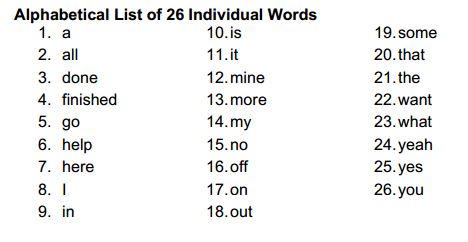
*See also this article by Bruce Baker for more examples and additional core vocabulary lists
Core words are powerful words. Just look at some of the phrases and sentences that can be made from just the toddler list above:
- All done.
- I go here.
- This is mine.
- I want some.
- What is that?
- Yes it is.
One thing I have noticed in the language development of both of my girls living with autism is that most of their first words were: nouns, nouns, nouns and more nouns. They did not develop functional core word language like a typically developing toddler or preschooler. My theory of why this might sometimes happen in those with autism is perhaps there is a remarkable difference in the language processing center of the brain, or nouns, nouns, nouns and more nouns language acquisition is a protective sensory processing measure akin to lining things up.
My girls tend to label, label, label things around them to perhaps makes sense of the world around them– and to feel safe in the world around them due to their sensory processing differences. One of the most common language enrichment practices seen in preschool and young elementary classrooms is the labeling of items in the classroom to help youngsters learn to recognize the printed pattern of common words and items in their surroundings.
A simple and fabulous suggestion I heard at a recent core vocabulary professional development session I attended is this: label things around the classroom or the home with core word phrases to help learners with delayed language acquisition gain additional exposure to functional core word meanings in the context of their play and learning environment.
~KVS
“For I know the plans I have for you,” declares the Lord, “plans to prosper you and not to harm you, plans to give you hope and a future.” ~Jeremiah 29:11.
Permalink Comments off
Hello Blog….How I have missed you….AAC journeys
Hello blog. How I have missed you.
Seeing all the Facebook and tweets about ATIA2015 has made me open the wordpress! It’s a great time to write again. I am in my 4th semester of graduate school at BGSU. I am doing an online masters program in Assistive Technology. I love it so far.
On the AAC front, its once again time to re-evaluate and fine tune the current AT and AAC needs of my Gilly Bean. When Gilly first began her AAC journey, we utilized the pediatric speech and language pathology department of C.S. Mott Children’s Hospital at the University of Michigan. Her first device was a DynaVox Maestro funded by our private medical insurance in 2010. It is now known as the “Take a Bath” talker. No we don’t let it get wet, but the most often phrase it now utters is “TAKE A BATH.” The Maestro is in the perfect and convenient location to say “Take A Bath” on the way upstairs to a beloved sensory escape of bath time for Miss Gillian.
Even with insurance funding most of the cost of the device, we were still responsible for about 20% of the cost which was paid off over 18 months thanks a zero cost zero% loan made available to families by the then singular DynaVox Corporation (DynaVox is now Tobii DynaVox after their merger). So needless to say, though now not used as a portable dedicated AAC speech device for Gillian, it now sits as a sort of ‘extra windows workstation’ / ‘take a bath requester’ on the desk in our dining room. It still functions well as a talker when needed, but probably more so now is a spare Facebook browser, Spotify broadcaster (great speakers for that), and email checker. It maybe could be labeled as the first entry in our living AAC museum of sorts. Sometimes our first generation iPad is sitting nearby getting charged up, a likely second entry soon to the living AAC museum.
When we moved to a different school district about 18 months ago, Gilly also began a center-based ABA program. Together with our school team and our BCBA/SLP, we made the switch to Proloquo2Go on an iPad mini. The Maestro was too heavy for her to ever carry around with much ease, so we really wanted to try an AAC app on the iPad mini. Because she had been using modified Gateway 40 on the Maestro, what I essentially did was ‘reconstruct’ her Maestro vocabulary as closely as possible based off of ‘core’ in Proloquo2Go. She did very well with the transition and within a month, we were no longer using the Maestro, but still made it available in a dedicated location. It gradually became the “Take a Bath” talker.
Here is a screenshot of her Maestro homepage based on Gateway 40:
Here is a screenshot of her Proloquo2Go homepage based on her Maestro page set:

For Proloquo2Go, I used 6 columns by 6 rows to result in a similar button size when the iPad was used in either portrait or landscape. This system has been working well for her the past 18 months. She navigates pages easily and knows the location of vocabulary. She is brilliant at receptive ID activities, also the tacts, mands and fill-ins of her ABA program. But we are all still noticing something: She is not reliably building two word phrases and sentences. Most of her use of the device is still predominantly single object requests and occasionally comments.
I’ve been to several presentations about core vocabulary and language acquisition via motor planning. I’m also inspired by the emergent practice and research supporting aided language input and modeling of language by communication partners with AAC. We are now on the search for our next and more robust core language based system for Gillian. We are brainstorming ways to build more core based phrases and language modeling into her school and ABA program. Stay tuned.
~KVS
“For I know the plans I have for you,” declares the Lord, “plans to prosper you and not to harm you, plans to give you hope and a future.” ~Jeremiah 29:11.
Permalink Comments off
